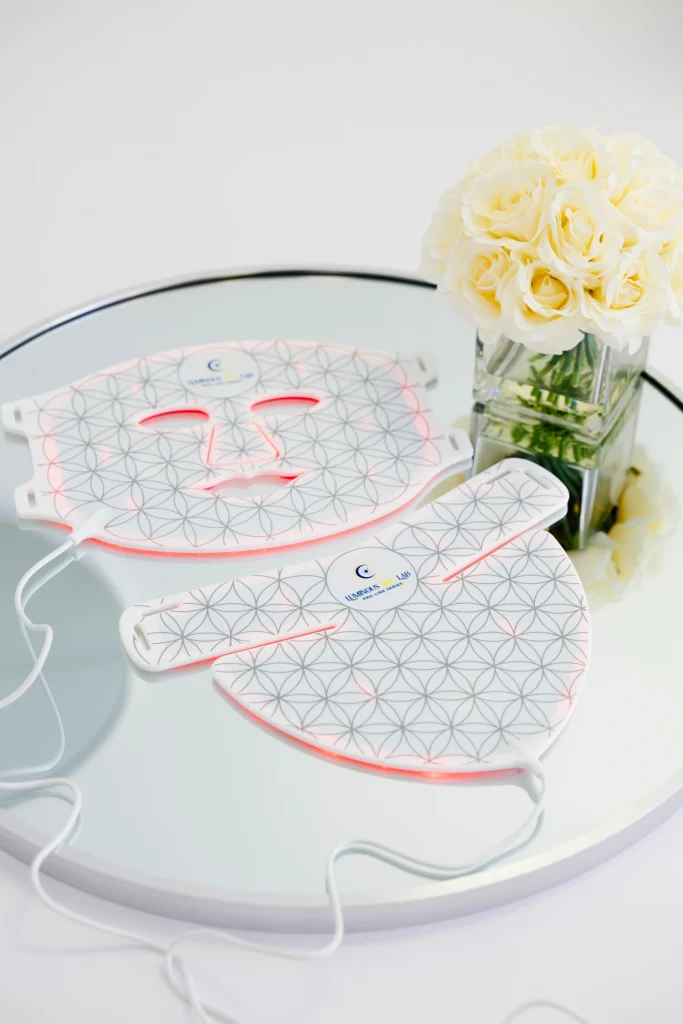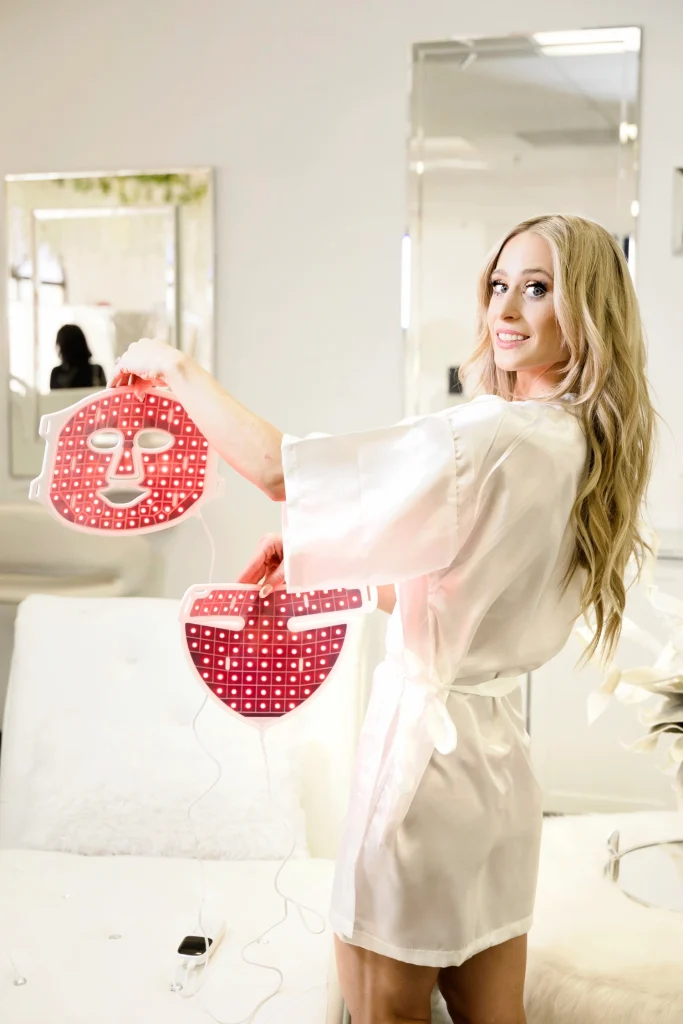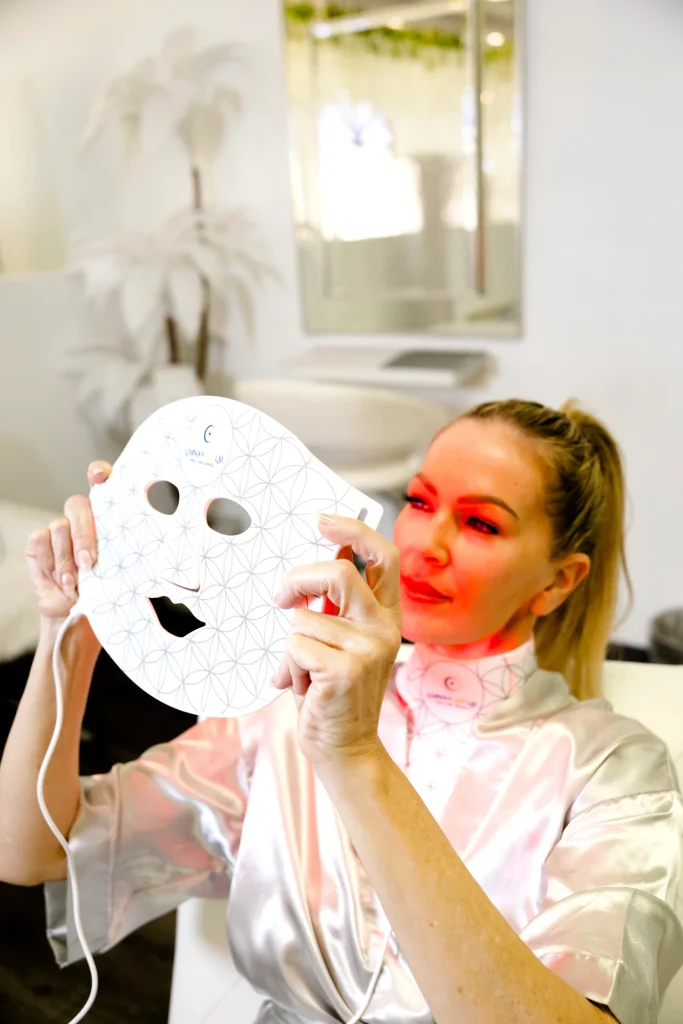At-home red light therapy devices for home use have exploded in popularity over the past few years. Every brand now claims to offer “professional results,” yet half of them barely light up your skin. Some use weak LEDs. Others skip proper wavelengths or have zero safety clearance. So, before you spend a few hundred dollars on a mask, you should ask yourself: What should I look for in a red light therapy device?
Look for the right wavelength range, full and even light coverage, FDA clearance, and a design that feels comfortable enough to use often. Those factors decide whether you will see real results or just a soft glow with no payoff.
Here’s a breakdown of the critical features, device types, and safety markers that separate reliable technology from pretty gadgets.
Key Features That Define a Quality Device
A good red light therapy device is all about balance. You need to make sure that it has all the essential features. The most important ones are listed below.
Wavelength Range
The type of light matters more than brightness. Red wavelengths between 630 and 660 nanometers reach the upper skin layers. They boost collagen and improve the tone of your skin.
Near-infrared light at 850 nanometers goes deeper to support repair and circulation. When both wavelengths work together, you can expect red light therapy to revitalize your skin.
LED Density and Coverage
When choosing the best LED red light therapy mask, it’s important to check that it doesn’t leave dark patches or uneven exposure.
The more LEDs it has, the more balanced the treatment you’ll get. Sparse lights can’t deliver uniform energy, so the results will end up uneven.
Look for full-face coverage with at least 500 LEDs. The ILUMILUX mask uses 680 medical-grade LEDs, which give consistent light across the face and neck for salon-level results at home.
FDA Clearance and Certification
Safety matters. When you choose an FDA-cleared LED mask, you know your red light therapy device for home use meets strict safety standards and delivers energy levels that have been clinically tested.
It also means the light is steady, effective, and safe for your eyes. Devices without FDA clearance might not go through the same testing or regulation, so it’s always smart to check this before you buy.
Comfort and Design
A mask that’s awkward or heavy will often end up unused. Ergonomic design, adjustable straps, and lightweight materials are some of the things that you should pay attention to. ILUMILUX pairs high power with comfort, so each session feels natural and easy.
| Feature | Why It Matters | Ideal Standard |
| Wavelength | Determines how deep light reaches | 630-660nm (red), 850 nm (infrared) |
| LED Count | Ensures even coverage | 500+ LEDs for full-face masks |
| FDA Clearance | Guarantees tested safety | Required for home devices |
| Comfort | Encourages steady use | Lightweight, adjustable fit |
What Should I Look for in a Red Light Therapy Device?
When you’re picking a device, you need to understand what kind of results you want. Here are a few tips to keep in mind.
- Match it to your skin goals. Not every device focuses on the same issue. Some are built for fine lines and tone, while others support recovery or inflammation control. Think about what your skin actually needs before you make the purchase — that alone will help you narrow things down fast.
- Look for real results, not hype. Select devices with clear before-and-after progress. User reviews should describe consistent improvement, ideally backed by studies like those in Photomedicine and Laser Surgery (2007), which validate the benefits of specific wavelengths.
- Check session time and power output. Short, effective sessions will make life much easier for you. Some high-quality LED face masks need only ten minutes, while others take closer to thirty. Choose the one that fits your schedule best — that way, you can actually stick with it and see results.
- Go for adjustable settings. Different skin types react differently to light exposure. If you choose the right mask, you’ll have more control and your skin will be able to adapt slowly. It’s also a plus if you can target separate areas like the neck or jawline;
- Ease of use always wins. A red light therapy device should be effortless. You shouldn’t have to sit perfectly still or hold it in place. The easier it feels to use, the more often you’ll reach for it — and that’s what brings results.
- Quality over extras. Skip add-ons that don’t do much. Some masks include music, heat, or fancy remote apps, but they don’t change the light quality. Focus on a solid build, even light flow, and reliable materials.
ILUMILUX was built around these same ideas — simple design, clear results, and a routine that actually sticks.
Comparing Device Types and Uses
Red light therapy tools come in a few different forms, and each one suits a different kind of routine. Take a look at the red light therapy device comparison below:
- Panels. These are the large, full-body setups you often see in gyms or clinics. They cover a lot of space, making them great for recovery or body treatments. The only drawback is that they’re bulky and need a fixed setup, which isn’t ideal if you want something quick or portable.
- Handheld Tools. Best for small areas like the jawline or around the eyes. They let you target specific spots, but they take time since you have to move them section by section. It’s precise but not always practical for full-face use.
- LED Masks. These are the most convenient for everyday skincare. They cover the entire face evenly, stay hands-free, and work while you relax. The Journal of Clinical and Aesthetic Dermatology (2021) – At-home LED efficacy study supports the benefits of LED masks for consistent skin improvement. The ILUMILUX best LED red light therapy mask goes a step further with medical-grade LEDs and a comfortable fit that feels natural to wear. You get the power of a clinic treatment at home without any effort.
- LED Helmets. Made specifically for the scalp, these help with circulation and hair growth. They’re good for that purpose, but don’t replace facial or skin-focused devices.
Each style has its own advantage, so pick the one that matches your preferences.
Which Type of Red Light Therapy Device Is Best for Home Use?
When it comes to safe red light therapy at home, the best red light therapy devices are the ones that fit easily into your daily life. You don’t need something bulky or complicated. You need a tool that feels simple, safe, and quick to use.
Big panels might look impressive, but they take effort to set up and need space you might not have. Handheld wands can work well too, but they take time since you have to move them around bit by bit.
Most people want something that doesn’t demand much — something you can put on, press a button, and let it handle the rest. That’s why LED masks stand out. They treat your entire face evenly and free up your hands while you read, scroll, or unwind. You don’t have to think about positioning or timing. It’s easy, comfortable, and effective.
A high-quality LED face mask like ILUMILUX offers the same kind of power that professionals use in clinics, but in a form that fits at home. It’s light, comfortable, and covers the skin evenly — all the things that make you actually want to use it.
And that’s the real key to results: the device you’ll reach for again and again, not the one that ends up stored away.
How to Verify Safety and Results
The safest way to know if a red light therapy device is trustworthy is to study it closely yourself. A few quick checks, including referencing the FDA Medical Devices Database, can help you see if the brand takes real testing and safety seriously.
The first thing you should pay attention to is FDA clearance. That label means the device meets medical safety standards. It confirms that the light levels stay within the limits for non-thermal exposure and that it won’t harm your skin or eyes. If a company can’t show this, it’s better to skip it.
Next, see if the brand mentions independent testing or clinical trials. Reliable products often appear in small clinical studies or have data shared through dermatologists.
When you know these results, you can be confident that the device supports collagen renewal and skin recovery in real conditions, not just on paper.
Pay attention to product quality too. The materials, wiring, and LEDs matter. If they’re medical-grade, the mask will likely last many years. You can also spot strong brands through clear warranties and customer support. These are good signs that the company stands behind its build quality.
Here’s a simple checklist to make things easy:
- FDA-cleared LED mask listed by name and code;
- Published test results or verified clinical data;
- Medical-grade LEDs with uniform light coverage;
- Positive long-term user feedback and warranty details.
The ILUMILUX mask is built for performance. It uses 680 medical-grade LEDs, offers even full-face and neck coverage, and carries FDA clearance. That means it’s both safe and proven.
How Do I Know if My Red Light Therapy Device Is Safe and Effective?
If you plan to buy a mask, the real question is how to choose red light therapy device that actually works. Here are some of the things that you should know about:
- Start with how the brand communicates. An honest company will always list its wavelengths and light output clearly. When you see exact details like 630 nm red light and 850 nm near-infrared, you get a sense of how it works. Vague claims like “powerful anti-aging light” usually hide weak specs.
- Then, focus on real outcomes. Reliable devices show before-and-after photos from users who used them regularly. Look for steady improvements — smoother tone, fewer fine lines, or calmer skin. If you notice that most users mention visible progress within a few weeks, then it’s usually a good sign.
- Make sure that it’s comfortable. A good mask feels balanced on your face and doesn’t create heat spots or pressure. For safe at-home light therapy use, the device should distribute energy evenly. In that case, sessions will feel comfortable.
- Lastly, check if the product includes clear directions for use. A responsible brand always explains how long to wear it and how often to repeat sessions. This way, you can get results without irritation or fatigue.
Conclusion – Choose Smart, Glow Confidently
The way a red light therapy device for home use performs comes down to how it’s designed — the balance of power, wavelength precision, and built-in safety. When all of that works together, you see real, lasting results.
ILUMILUX was built with that in mind. It uses clinical-grade light, covers the whole face evenly, and feels light enough to wear without any hassle. It’s FDA-cleared, so you know it’s been tested to meet real standards — not just promises on a box. This kind of device doesn’t just brighten your skin — it builds strength under the surface. Over time, your skin feels firmer, looks smoother, and holds that healthy glow longer.
Smart skincare doesn’t need to be hard. ILUMILUX makes safe red light therapy at home simple and reliable — so your skin can do what it does best: renew, repair, and shine.
FAQ
No. Some use weak light or the wrong wavelengths. The right mask uses strong, even light in the right range to actually help your skin.
Yes. It means the device passed safety tests and meets standards for home use. If it’s not FDA-cleared, skip it.
Look for at least 500. More LEDs give better coverage, so every part of your face gets equal light.
Yes. If your mask is FDA-cleared, daily use is fine. Stick to 10–20 minutes per session.
No. It feels warm at most, but it doesn’t burn or sting. There’s no downtime after a session.
Sure. Red light therapy works well alongside most skincare routines and treatments like microcurrent, gentle exfoliation, or hydrating masks.



